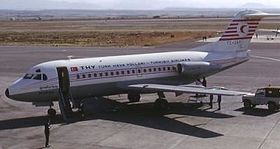Turkish Airlines Flight 345
| Turkish Airlines Flight 345 | |
|---|---|
|
The unlucky machine, photographed on January 1st, 1975 |
|
| Accident summary | |
| Accident type | Controlled flight into water |
| place | Sea of Marmara |
| date | January 30, 1975 |
| Fatalities | 42 (all) |
| Survivors | 0 |
| Aircraft | |
| Aircraft type |
|
| operator |
|
| Mark |
|
| Surname | Bursa |
| Departure airport |
Izmir-Cumaovası Airport , Turkey |
| Destination airport |
Istanbul Yeşilköy Airport , Turkey |
| Passengers | 38 |
| crew | 4th |
| Lists of aviation accidents | |
Turkish Airlines Flight 345 (flight number: TK345 ) was a scheduled domestic flight of the Turkish airline Turkish Airlines from Izmir to Istanbul , on which a Fokker F28 went missing on January 30, 1975 . Only seven years later, with the discovery of the wreck at the bottom of the Marmara Sea , physical evidence of the crash of the machine could be produced. 42 people were killed in the accident.
At the time, it was the third most serious aircraft accident in Turkey.
prehistory
After Turkish Airlines flight 301 (with the same type of aircraft) had a very serious accident on the same route and direction in January 1974 - 66 dead, 7 injured, total loss - subsequent flights were carried out using the new flight number TK 345.
plane
The machine was a Fokker F28-1000 , which since its first delivery to Turkish Airlines in 1972 had completed 3713 flight hours and 5062 take-offs and landings. The machine had been christened Bursa . It had the serial number 11058 and the aircraft registration TC-JAP .
course
The aircraft was on a scheduled flight from Izmir to Istanbul on January 30, 1975 in the dark . The flight to Istanbul started at 6:00 p.m. and initially went smoothly. The aircraft touched down on the runway at 18:39, but the next moment a missed approach was initiated because at the moment of landing the airport runway lighting had failed due to an electrical fault . The pilots let the machine rise to a height of 240 meters. After the lights could be reactivated via the emergency power supply 22 seconds after the missed approach, the crew asked for permission to land at 1843 and prepared a second approach. Air traffic control they had of the imminent start of a Boeing 707 of Pan Am on to fly an extended hold. When the air traffic controllers tried to contact the aircraft ten minutes later, at 6:53 p.m., they received no answer.
Find and whereabouts of the wreck
At first there was uncertainty about the whereabouts of the aircraft. After all, it took seven years until the crash site at the bottom of the Sea of Marmara, 30 kilometers west of the airport, could be located. The pilots had flown the machine into the water above its actual altitude in a disoriented manner ( controlled flight into terrain ).
After the discovery of the wreck, the families of the victims asked the Turkish authorities in vain for years to rescue the wreck. On March 17, 2009, crab fishermen finally pulled a 3 × 3 meter piece of debris with a mass of 200 kilograms off the coast of Avcılar . After the aviation historian Stuart Kline had examined this part - a fragment of the rear with five window frames - he handed it over to Turkish Airlines.
Individual evidence
- ↑ a b c d e Accident report F28-1000 TC-JAP , Aviation Safety Network (English), accessed on March 2, 2019.
- ↑ Korkunç iddia! Stuart Kline; Devlet 'sus payı' alarak kazanın üzerini loktü! THY derhal yanıtla ve çıkart! ( Turkish ) Hürriyet Port. June 15, 2009. Archived from the original on June 16, 2009.
Coordinates: 40 ° 44 ′ 49.9 " N , 28 ° 39 ′ 57.6" E
